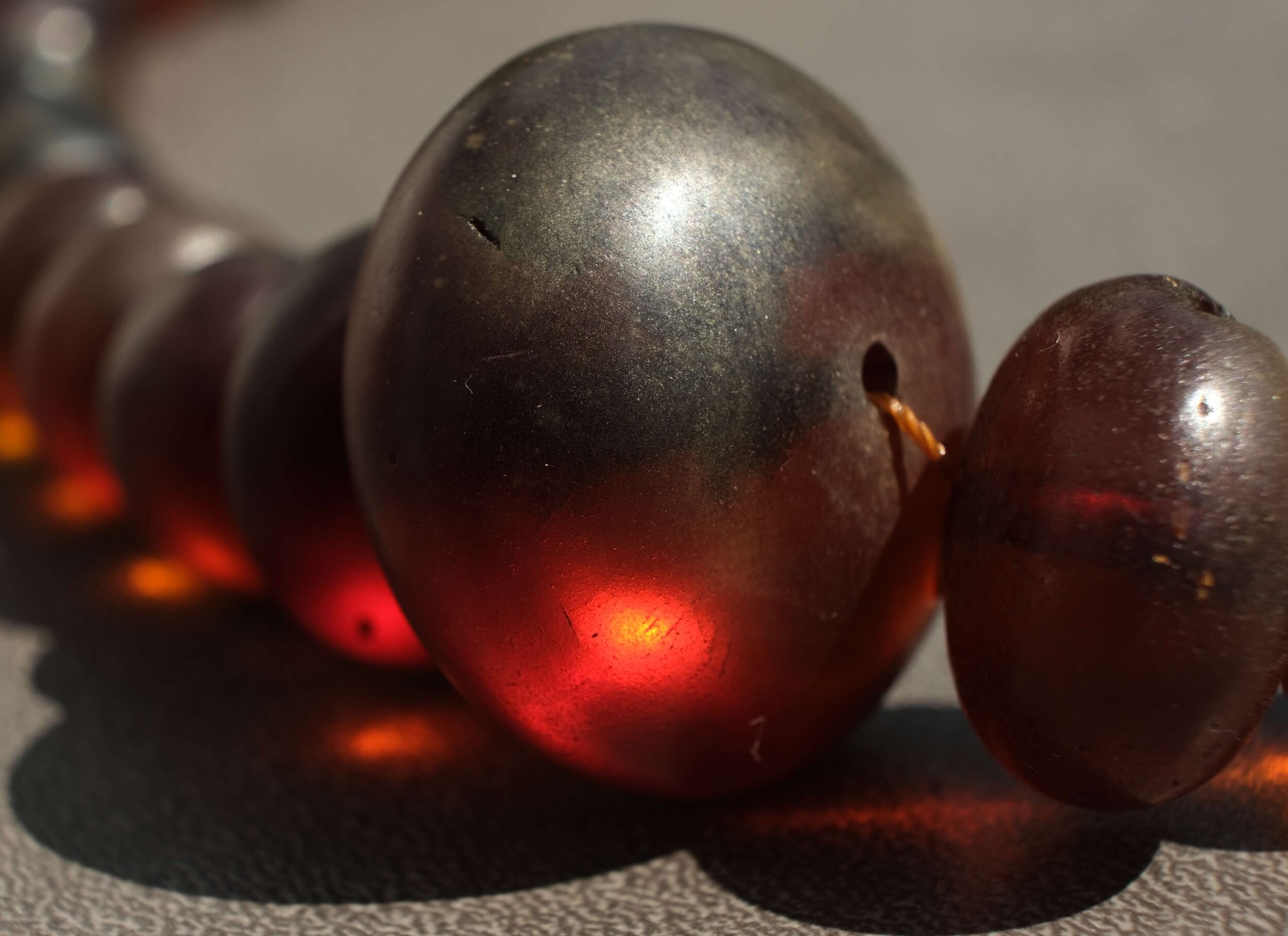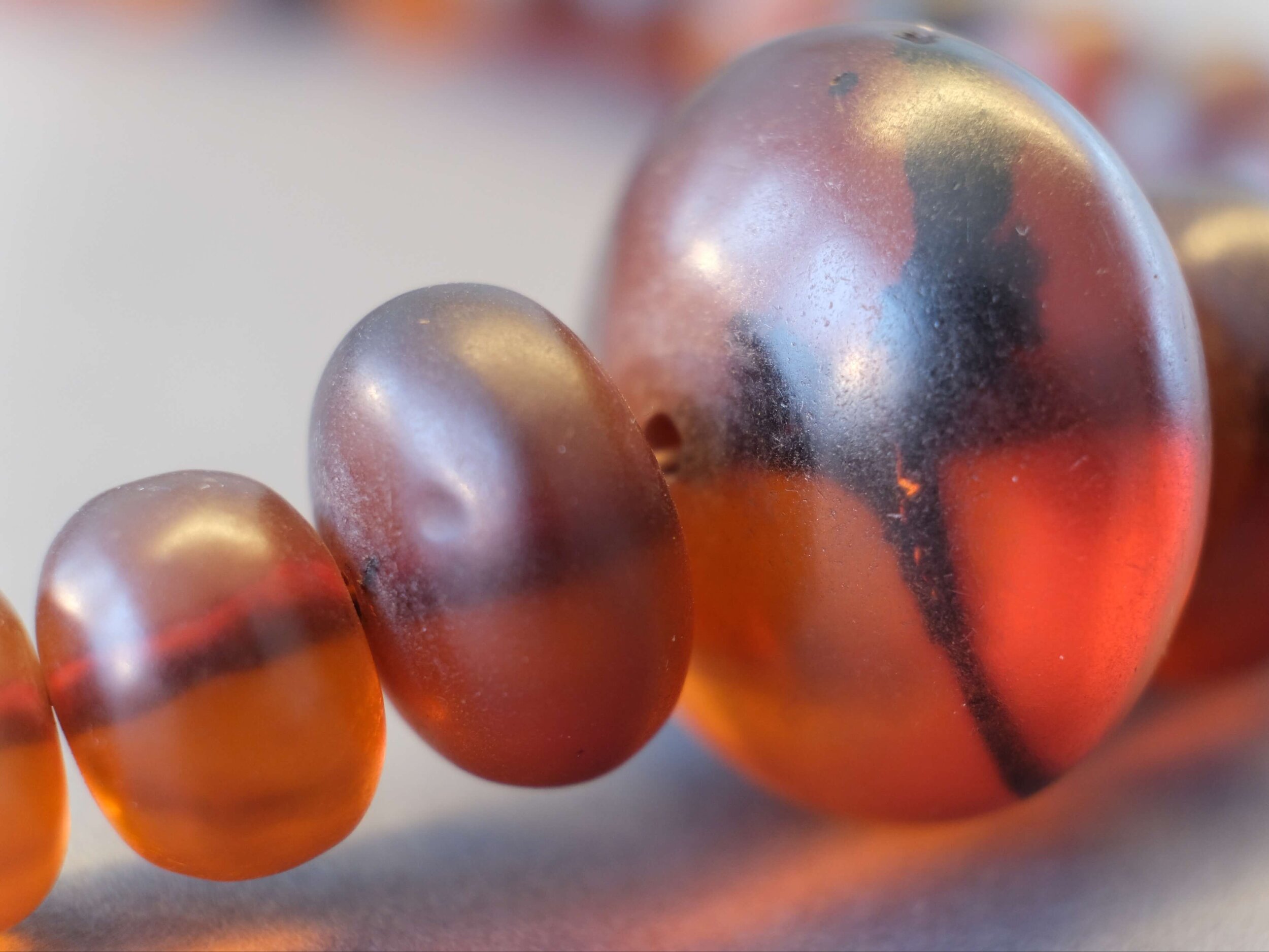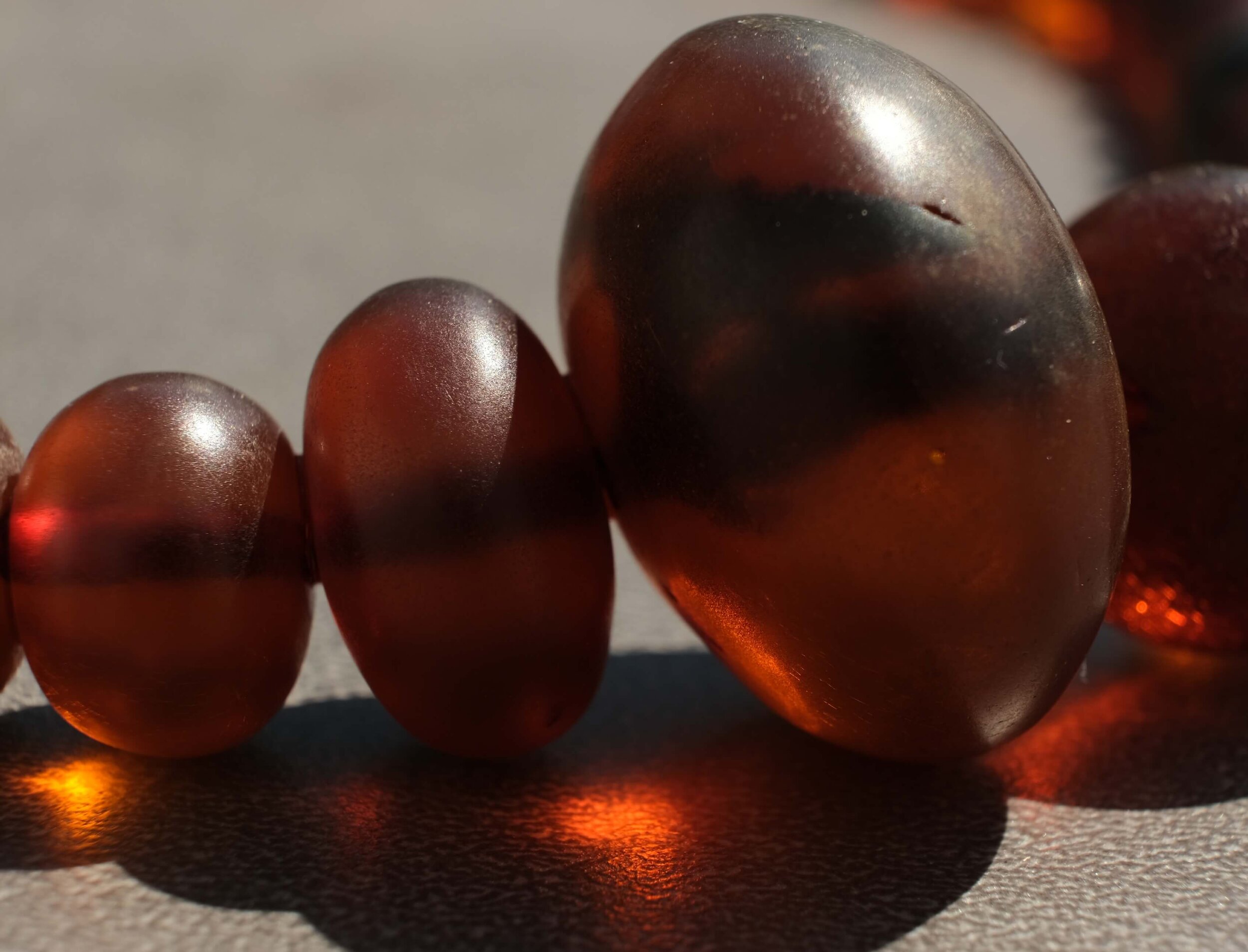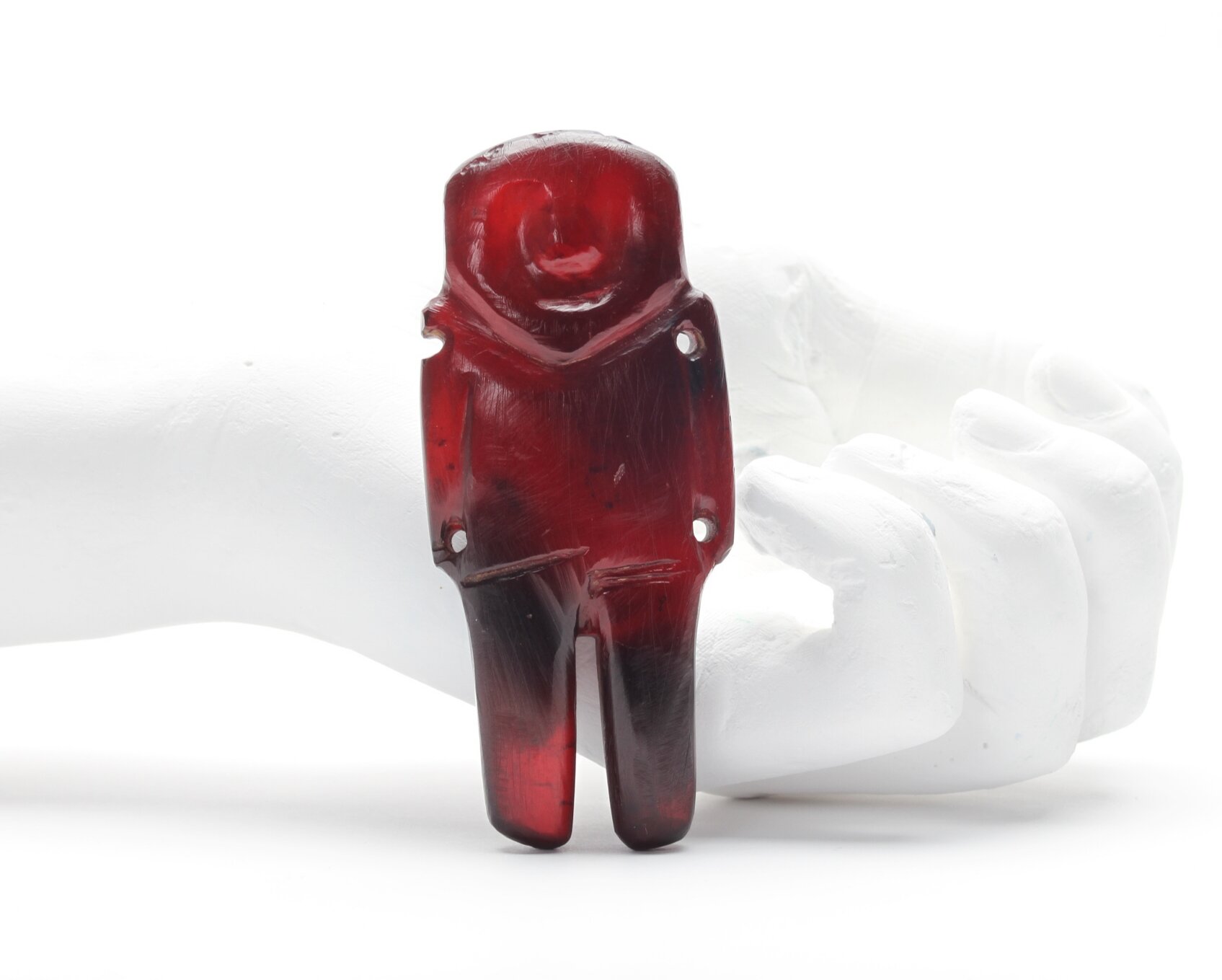Amber Art / Amber Jewellery
Mythology/protective stone
The light weight and electromagnetic chargeability as well as simultaneous combustibility has given amber a certain magic in prehistoric times. For thousands of years, amber has been used as a protective stone and amulet. A "stone", courted by legends and myths, desired and mysterious. A stone that feels warm to the touch, is light and transparent, irradiated by sunlight in mild yellow tones, often shining almost golden or even orange-fiery. A stone that burns. Already in prehistoric times the natural philosopher Thales of Miletus /ca. 624 -546 B.C.) recognized the property of amber after rubbing it with a wool cloth to attract small objects, which we today call static electric charge. It is not surprising that amber has been used as a protective stone and amulet for thousands of years. Excavations of preserved grave goods such as the multitude of amber lucky charms in all European regions since prehistoric and early antiquity up to the Middle Ages confirm this.
Faya Causey writes the following in her beautifully written book "Amber and the Ancient World”: "The myths and realities and the nature and power of amber influenced the desire to aquire it" (page 21). I can fully agree with her statement. She confirms that amber amulets should protect people; "As early as Mesolithic in northern Europe, amber was shaped into or embellished with potent symbols of the sun, fertility, and regeneration. Amber amulets shielded owners from harm, cured or prevented disease, or ensured safe passage to the hereafter" (Faya Causey, page 27).
Traditional medecine
Amber has been used in traditional medicine for thousands of years. For example, the Roman doctor Kalistrat wrote that amber mixed with honey cured ear, throat and eye diseases and stomach diseases. For the Persians it was considered to be a medicine against various diseases, but in China green amber was used in the form of syrup together with opium as a sedative. After the birth of Christ, amber was used in the church instead of incense. It cleaned and disinfected the air. Amber smoke was also used for respiratory diseases. In the Middle Ages amber bracelets were worn to relieve joint and muscle pain. Doctors recommended it for stomach and toothache or throat problems. In 1932 some doctors recommended the following: "Amber oil is an external and internal remedy against rheumatism, is effective against whooping cough and asthma, and works as a stimulant" (Danish Amber Museum, page 100). To this day amber necklaces are often worn by teething children.
Also, the use of fresh resin or copal was regarded as folk medicine by many peoples. In Mexico, copal has the same status as incense among Europeans and the inhabitants of the Middle East. The indigenous advanced civilizations of Mesoamerica used copal as incense in their sacrificial rituals and as a remedy for many types of illness (e.g. asthma, colds or diarrhoea). In earlier times, people in South America, Northern Europe (Sweden), partly in Central Europe and Siberia chewed resin products to care for their teeth.
Amber Art / Amber Jewellery - since thousands of years
Amber Art in the Neolithic Age
Already in the Neolithic Age people carved human and animal figures from amber with the help of flint knives. The find from Schwarzort (in the Curonian Lagoon in Lithuania) is the most extensive amber find from this period (3rd millennium BC). In the beautiful amber museum in Nida (Amber Gallery-Museum) we admired the famous "Schwarzort treasure". We had some exhibits reproduced (see photos).
amber find schwarzort
Neolithic Age
amber find schwarzort
Neolithic Age
amber find schwarzort
Neolithic Age
Amber findings in Switzerland
In her dissertation "Central European Amber Finds from the Early Bronze Age to the Spring La Tène Period" Dr. Christa Stahl has analysed the distribution, shape, dating and origin of amber finds in a very profound way. Her work is unique and provides an overwhelming amount of information. In the map (see map) we have entered all known sites in Switzerland.
One of the most beautiful finds of the Swiss Bronze Age (2200-800 B.C.) is the amber pearl from the excavation in Zurich's Mozartstrasse. It is a find from a lakeside settlement of the Early Bronze Age. The beautiful amber pearl with gold plating has a diameter of almost 3 cm. and is exhibited in the National Museum in Zurich. We had a replica made for our collection (see photo).
amber find late bronze age
Mozartkugel, Zürich, Switzerland
In the last phase of the pile-dwelling epoch (Late Bronze Age) it was relatively common that women's graves were decorated with grave goods such as glass or amber beads. This is true for Western Switzerland (Lake Geneva, Lake Neuchâtel) as well as for the Central Plateau with its lakes (Lake Hallwil, Lake Baldegg, etc.) and for Eastern Switzerland with its lakeside settlements along Lake Constance. According to the analyses of the researchers, the amber pearls are made of Baltic amber. It seems that even in very simple lakeside settlements there was some luxury. The question with what the local inhabitants traded in order to be able to afford such luxury goods has not yet been definitively clarified.
In the Late Bronze Age, it was customary in Switzerland to clasp dresses with fashionable bronze needles. This is documented by 300 needle finds from Mörigen on Lake Biel. Even back then, Italy influenced fashion. In Mörigen 4 vestment clasps, so called caterpillar fibulae from Italy from 900-800 BC were found. We had the caterpillar fibula copied in amber (photo replica).
caterpillar fibulae
Late Bronze Age
Switzerland is also rich in archaeological evidence from Celtic times. In many women's graves amber necklaces or earrings with amber beads have been found. In the Rhaetian Museum in Chur there is a very beautiful amber necklace from a grave in Castaneda GR, from the 5th century BC (photo replica). Earrings made of bronze with amber beads from Trun GR, 4th century B.C. also surprise (photo replica).
celtic amber necklace
Castaneda, GR, Switzerland




celtic earrings
Trun, GR, Switzerland



Vikings and amber
Also, the Vikings traded a lot with amber. They were successful sailors and traders. Archaeological findings in important trading places prove "that there were also amber cutter workshops which made rings, pearls and amulets from raw amber" (Jens Grzonkowski, Bernstein, page 73). More than a thousand years ago Sigtuna was Sweden's most important trade centre. The very idyllic Sigtuna is regarded as Sweden's oldest town. In the Sigtuna Museum & Art we have seen an amber dice from the Viking Age, of which we had a replica made for our collection (photo replica).
amber dice from the Viking age
Sigtuna, Sweden
Amber in the Middle Ages
In the 13th century, the Order of German Knights had secured for itself the ownership rights to the extraction and processing of Baltic amber. From the 14th century onwards, the unauthorized collection of amber was temporarily punishable by death. For a long time well visible gallows along the entire Samland coast (area between Gdansk and the Curonian Spit) drew attention to the severe threat of punishment. During the Middle Ages amber was very expensive. Many luxurious art objects were made for noblemen, princely families and the church. In the books "Bernstein-Kostbarkeiten sowie Bernstein für Thron und Altar" a lot of beautiful amber objects are illustrated. These are large sculptures, bowls, candlesticks (see photo), sailing ships, magnificent lidded tankards, giant showpiece lamps, showpiece caskets, cups, boxes, game caskets, hunting cutlery, versed boxes, flacons, an amber armchair (throne armchair for Emperor Leopold I), a cabinet, altars, crosses, rosaries and much more.
candlestick - KÖNIGSBERG, 1600
Replica (pressed amber)
Modern amber jewellery
Poland is world-famous as a processor of amber. We have visited numerous studios and workshops in Gdynia, Gdansk and Sopot. Gdynia is a very lively port city with modernistic flair. Gdansk with its colourful Old Town offers visitors a journey back in time to the Middle Ages. Gdansk is the centre of the worldwide amber trade. Sopot is located between Gdansk and Gdynia and is a spa town with beautiful sandy beaches and a magnificent Grand Hotel. The small company Gliwinski in Sopot produces exclusive and uncluttered amber jewellery (see photo). Some selected pieces of jewellery and objects from this region belong to our collection today.
modern jewellery
aleksander gliwinski
Sopot, Poland
Modern amber jewellery (Aleksander Gliwinski, Sopot, Poland)
Literature:
Elisabeth Bleuer et al, Die Neolitischen und bronzezeitlichen Seeufersiedlungen des zentralen Mittellandes, Archäologie der Schweiz, 27.2004.2, Seiten 30 – 41
Sabine Bolliger Schreyer, Pfahlbau und Uferdorf. Leben in der Steinzeit und Bronzezeit. 2004, Bernisches Historisches Museum, Chronos Verlag, Zürich
Ole Faber / Lene B. Frandsen / Mariann Ploug, Amber, 2000 The Danish Amber Museum, PE offset & Reklame, Dänemark
B. Fatzer / Urs Leuzinger, Pfahlbauquartett, 4 Museen präsentieren 150 Jahre Pfahlbau-Archäologie, 2004 Grafische Unternehmung und Verlag, Frauenfeld
Jens Grzonkowski, Bernstein, Edition Ellert& Richter.
Irmgard Grüninger, Texte zur prähistorischen Sammlung im Historischen Museum St. Gallen, 1995
Albin Hasenfratz et al, Pfahlbaujuwelen am Bodensee. 27.2004.02, Archäologie der Schweiz, Seiten 4 - 15
Georg Laue, Bernstein Kostbarkeiten Europäischer Kunstkammern, 2006 Druckerei Peschke, München
Virginija Mitzgiris / Kazimieras Mitzgiris, Mysterious Amber World. UAB Gintaro Galerija. 2000
Felix Müller, Das keltische Schatzkästlein. Schmuck als Zier und Zeichen. Glanzlichter aus dem Bernischen Historischen Museum, 1999, Chronos Verlag, Zürich
Ingrid R. Metzger, Schmuck der Alpen. Von der Prähistorie bis zum Frühmittelalter. Rätisches Museum Chur 1998
Wilfried Seipel, Bernstein für Thron und Altar. Das Gold des Meeres in fürstlichen Kunst- und Schatzkammern. Kunsthistorisches Museum Wien. 2006
Christa Stahl, Mitteleuropäische Bernsteinfunde von der Frühbronzezeit bis zur Frühlatènezeit. Ihre Verbreitung, Formgebung und Herkunft. 2006 Verlag J. H. Röll, Dettelbach










